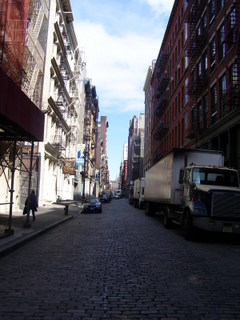Soho/Our Tour
From The Peopling of NYC
These cobble stones were once used as ballast to balance empty ships that came to America for cotton.
A walk through the historic cobble streets of SoHo overwhelms one with a feeling of conflict between the old and the new. Everywhere one looks, the clashing forces struggling for preservation and those forcing modernization through a seemingly endless influx of capital shout out. These shouts make for an electrical charisma of the neighborhood, one that decade after decade drew new and fascinating groups to make it their home. More recently, the neighborhood has become a hot-spot for tourism.
Upon acclimating to Soho's fast pace and atmosphere, the walker-by begins to gaze at the neighborhood's marvelous cast-iron archetecture. It is to protect this architectual relic that the city has zoned Soho as a historical district. These buildings have strong skeletons that hold the weight of the building form the interior. Therefore, their fronts allow for huge windows, which have become useful for today's storefronts.
These windows into the past reveal Soho as it was from 1825 and throughout the 1850's - a factory district. Its organization into such is by no means accidental. It was a logical extention of the demographic environment of the surrounding neighborhoods. This environment largely consisted of two two immigrant groups: Irish and Italians. The cheap labor from the surrounding tennements and boarding houses allowed for ornate factories to be built in this prime location. Its proximal location to Downtown Manhattan, where the immigrants were largely concentrated, allowed for walking to work, a characteristic that was absolutely crucial for any poor immigrant worker during the early 1800s. Benefiting from being in the right place at the right time, SoHo to evolved into an industrial district.
Factory owners were ruthlessly economical, exploiting the cast iron structures for every square-inch of workable space. Thus, the large basements underneath the buildings were considered prime working space and were packed with hardworking immigrant laborers. Walking by buildings where this basement work was once practiced, one steps on circular pieces of glass embedded in the floor. These were once translucent windows, providing light for the tired masses in the basements.

























